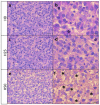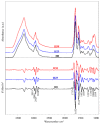Effects of Graded Dietary Inclusion Level of Full-Fat Hermetia illucens Prepupae Meal in Practical Diets for Rainbow Trout (Oncorhynchus mykiss)
- PMID: 31108939
- PMCID: PMC6562532
- DOI: 10.3390/ani9050251
Effects of Graded Dietary Inclusion Level of Full-Fat Hermetia illucens Prepupae Meal in Practical Diets for Rainbow Trout (Oncorhynchus mykiss)
Abstract
This study investigated the effects of dietary inclusion levels of full-fat Hermetia illucens prepupae meal (H) on growth and gastrointestinal integrity in rainbow trout (Oncorhynchus mykiss). A 98-day study was conducted using triplicate groups of trout (initial body weight, 137 ± 10.5 g) kept in 1-m3 tanks in a flow-through well water system. Three dietary treatments were prepared: one based on fishmeal and purified protein-rich vegetable ingredients (H0), and two experimental diets including graded levels of H meal (25% and 50%, referred to as H25 and H50, respectively). At the end of the feeding trial, no differences were observed in growth performance and plasma metabolite levels, with the biometric data confirmed by the liver expression of the genes involved in somatic growth regulation (igf1 and mstn1a). In the H50 group, a three-fold up regulation of liver hsp70 was observed. An activation of the stress/immune response (il-10, tnf-α, and tlr-5) was observed in medium intestine in the H25 and H50 groups (p < 0.05) together with a villi length reduction detected through histological analyses. Liver histology and Fourier Transform Infrared Imaging (FTIRI) spectroscopy highlighted an increase in lipid deposition. These findings suggest that caution should be taken into account when 50% replacement of conventional ingredients with H is selected.
Keywords: FTIRI spectroscopy; alternative proteins; black soldier fly; feed formulation; gastrointestinal health; growth metrics; plasma metabolite.
Conflict of interest statement
The authors declare no conflict of interest.
Figures







References
-
- Tacon A., Metian M. Feed matters: Satisfying the feed demand of aquaculture. Rev. Fish. Sci. Aquac. 2015;23:1–10. doi: 10.1080/23308249.2014.987209. - DOI
-
- FAO . The State of World Fisheries and Aquaculture 2018—Meeting the Sustainable Development Goals. FAO; Rome, Italy: 2018. p. 227. Licence: CC BY-NC-SA 3.0 IGO.
-
- Gatlin D., Barrows F., Brown P., Dabrowski K., Gaylord T., Hardy R., Herman E., Hu G., Krogdahl A., Nelson R., et al. Expanding the utilization of sustainable plant products in aquafeeds: A review. Aquacult. Res. 2007;38:551–579. doi: 10.1111/j.1365-2109.2007.01704.x. - DOI
-
- Glencross B.D., Booth M., Allan G.L. A feed is only as good as its ingredients—A review of ingredient evaluation strategies for aquaculture feeds. Aquac Nutr. 2007;13:17–34. doi: 10.1111/j.1365-2095.2007.00450.x. - DOI
LinkOut - more resources
Full Text Sources
Miscellaneous

